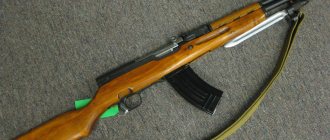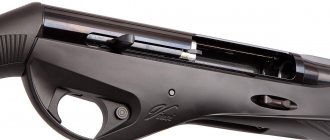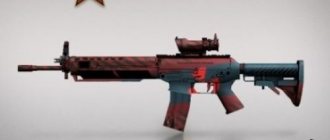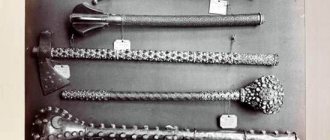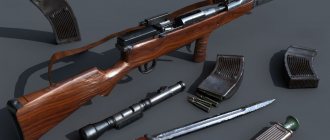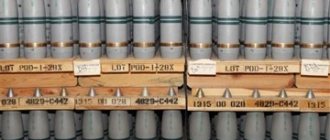Sai is a Japanese bladed weapon similar to a trident, in which the middle prong is several times larger than the others. It is more common in Okinawa, where there is even a special type of martial art in which they teach how to master the sai.
The length of this weapon can reach 600 mm, and the weight should be in the range from 500 to 1200 grams. Its side teeth are well sharpened and positioned in such a way that they can cause serious injury to the enemy. The weapon's hilt is most often made of rough leather, and can also be used in combat as a striking weapon.
When creating such a blade, much attention is paid to the balance between the blade and the handle, as this can significantly affect the speed of working with the weapon.
Origin of sai
The Japanese weapon sai has a very “foggy” origin. One theory says that the sai was not originally a weapon and was actively used in agriculture. If you pay attention to its unusual shape, you can assume that it was used for loosening the earth or some similar activity. However, not a single reliable fact was presented to prove this theory.
Another version says that these weapons came to Japan with visiting Buddhist monks from India, and they were used to protect especially important government officials. However, not a single reliable evidence was found in favor of this theory.
Due to the fact that the bladed weapon sai has become especially popular in Okinawa, another theory has emerged about the origin of this blade. In connection with it, it is believed that in feudal Japan it was used for weapons by local police, but again, evidence of this has never been found. To this day, there is lively debate about the origin of this weapon.
Stone Age weapons
Do you think that only aborigines of the ancient Stone Age could see weapons made of wood, stone and horn? However, hand-to-hand combat weapons of the period were, for various reasons, manufactured in many regions of the world until the 19th century, achieving extraordinary skill and practicality. Together with Magmens, let's look at the brightest wooden and stone weapons of our distant ancestors.
There were especially many such contemporaries of iron weapons in Polynesia. The inhabitants of Polynesia were very warlike, but it was problematic for them to make metal weapons, because ore could not be found on most of the small islands included in this region. And many of the islands are generally atolls made of dead corals. As a result, wood became the main raw material for the manufacture of Polynesian weapons. Moreover, these were not primitive clubs, but real works of art, decorated with patterns no less than their owners’ tattoos. Such weapons were not only beautiful, but also effective.
Samoan ax
The warriors of the Samoan islands especially stood out for their weapons. The Samoan battle ax was made from a single piece of "ironwood", known for its strong wood fibers. This war club actually had the shape of an ax with a leaf-shaped, flattened blade. Soaking the ax in mangrove mud before carving gave it a black color. This weapon was intended to break skulls and bones; they tried to hit the limbs and head with it.
Mudman Claws
Next on our list are Mudman Claws, from Papua New Guinea. Each “claw” is a piece of bamboo, with a diagonal cut at the end, about 15 cm long. The warrior put such bamboo tubes on each of his fingers and turned his hands into peculiar animal paws. Against unprotected warriors of the tropics, it was a formidable weapon, leaving serious cuts on the enemy’s body. Mudman claws were also psychological weapons: by striking the hollow claws against each other, the warriors created a frightening noise. Combined with traditional fearsome masks, Mudman claws gave warriors an intimidating appearance.
Macuavitl
Third place on our list is occupied by the Aztec “sword” - macuavitl. This weapon was a flat wooden club of a rectangular shape, but its edges were studded with “blades” glued into slots on the sides - sharp plates of black volcanic glass, obsidian. The sharp edge was used to deliver cutting blows, and the flat part was used to stun the enemy in order to take him prisoner. The Spanish conquistadors highly appreciated the quality of these weapons: according to their testimony, Aztec warriors managed to cut off the heads of Spanish horses with macuavitl. The disadvantage of the weapon was the fragility of its cutting edge - it had to be changed after an intense battle.
Makana
Rounding out our top is the makana, which was the main melee weapon of the Incas and their predecessors in the Andean region. The makana was a stick 60-70 centimeters long, with a star-shaped top resembling a gear. The pommel was made of stone, and its weight ranged from 200 to 350 grams. Light Peruvian helmets and traditional woolen caps softened but, of course, did not completely absorb the blow. As a result, after any battle there were a large number of wounded with traumatic brain injuries. This gave impetus to local medicine, which reached great heights in the field of craniotomy.
Making weapons Sai
The sai is created by welding two metal rods folded crosswise, the longest of which is the middle tooth, thickened downwards for attaching the handle, and the thickening also prevents the possible slipping of the dagger from the hands. The longest tooth is most often made round or edges are cut out on its sides, the tip of the blade is sharpened, in more rare cases the tip is left blunt. After welding the blade parts is completed, its side teeth are bent and sharpened. In some cases, the end of the handle may have special shapes (for example, a ball) that are specially adapted for striking. At the very end, after completing all the basic manipulations, rope or leather is wound around the handle, however, in rare cases it can simply be inlaid with a softer metal. It is also very rare to find a sai with one side prong bent in the opposite direction.
Pictish weapons and armor
Not a single piece of armor was found in the Pictish burials. Only one or two images suggest the presence of a quilted leather shirt. Archaeologists have so far found only one fragment of a scaly shell (at Carpough, Perthshire). At Noris Low, chain mail and a "rich scaly shell of small rhombic plates" were found, reminiscent of the Roman armor of lorica squamata. Both examples were apparently captured by the Picts from the Romans. Even helmets are extremely rare. The Aberlemno stone depicts a horseman wearing a helmet with characteristic nasal and temple plates. This helmet is reminiscent of those from Coppergate, Benty Grange and Burghcastle, but belonged not to a Briton, but to a Pict. The stone from Mortlach depicts a strange figure wearing a helmet with horns. Archaeologists have found only one fragment of a segmented helmet (spangenhelm), apart from the lost silver helmet from Norris Low.
Among the helmets that may have been used by the Picts is the helmet from Sutton Hoo, dating from the 5th-7th centuries. Reconstruction by Warren Green. The long sword with a wide rounded guard, an additional crosshair and a round head has also been lost. In addition, several fragments of Pictish swords were found, including several examples of the “end of the La Tène culture” with plates made of bone and antler. These swords are invariably found next to brochs. Two decorated hilt heads were also discovered. Pictish tombstones depict swords with wide, straight blades and a rounded tip. It is difficult to judge the length of swords from images. The rounded end of the swords is also confirmed by the shape of several surviving scabbard frames. This means that the Picts fencing with swords, delivering powerful slashing blows.
Spears for both one and two hands had wide tips. The shaft was made from raw branches, freshly cut from the forest. In "The Life of St. Columbus" there is such a phrase: "Scott carved the shaft for the spear with his knife." Simple one- and two-handed axes, as well as short saxophone knives, were also used as weapons. For the Celts, the throwing spear or javelin was the main offensive weapon. Such spears are depicted in the hands of Pictish warriors on a stone from Aberlemno. Darts were sometimes thrown with a belt: “darts with multi-colored silk cords and shiny nails flew at heroes of valor and courage.” In general, the weapons of the Picts are very similar to the weapons described in the North British epic: “They are armed with a spear and shield, a sword and a knife, those who are richer.”
Picts armed with bows are depicted on the reverse side of the Dapplin cross and on the Sueno stone. The Roman crossbow is depicted at Shandwick and St Vigens, and several crossbow bolts dating from the 7th to 8th centuries have been discovered. The crossbow had a low rate of fire, so it was depicted only in hunting scenes. But it can be assumed that the crossbow also had limited use on the battlefield. The Picts are reported to have used packs of war dogs, which could cause serious damage to an unarmored enemy. There is one known relief depicting the use of dogs by the Picts in battle.
The mounted Picts used round shields with a round umbo. The infantry had small square or round buckler shields. Irish and British shields of that period were called "linden", but the Picts' shields were clearly covered with leather, and also decorated with additional overlays, rivets and painting. In the Irish poem, the equipment of the Pictish knights includes "three black great swords, and three black shields, and three dark green javelins, as thick as a ramrod, from which a pot is hung on a fire."
The black color of the shields means that they were tarred. Highlanders often used this technique to make things waterproof. The swords and spears were not polished, so they retained the tarnished colors left after heat treatment. The iron parts were probably not polished to protect them from corrosion. In the north of Britain, the epithet "blue blades" is often found in poetry, while the broadswords of the Highlanders were called "great black blades".
The Picts had fortified settlements. Some of them had a large well and a church, like the "royal fortress" at Burghead. This indicates the large local population. But most of the settlements occupied a relatively small area, were built on rocky areas and were surrounded by a stone wall applied to the area. There were frequent battles near the settlements, although we know nothing of the Pictish methods of sieges.
Celtic weapons of the Dark Ages.
Celtic weapons of the Dark Ages. (a) Small Irish umbon. (b) Beeston tips. (c) Incendiary arrowhead, Dumberton. (d) Irish ribbed spearhead. (e) British spearhead, 6th century. (f) Scotch javelin head, Dunadd. (g) British dart point, Beeston. (h) Irish axe. (i) Handle of a spatha sword. (j) Sword hilt from Ireland. (k) and (l) Characteristic Irish broad-bladed swords.
Sai technique
Many existing techniques are adapted to specific varieties of sai, which have significant differences in their structure. In total, 4 types of this Japanese traditional weapon are known:
- Sakin - a blade made based on the prototype of the Japanese sai, in Malaysia
- Maji no sai - sai made in the form of a swastika
- Manji-sai - a sai, one of the side teeth of which is turned in the opposite direction from the central blade
- Bijiacha - Chinese imitation of sai
The technique of wielding this bladed weapon is in many ways similar to most others, since the sai has a wide variety of grips, and a rather unusual shape with three teeth. We can say that all existing types of attacks are based on stiletto and jitte techniques. For example, similarities with the jitte technique can be traced during the disarming of an opponent, when it is not necessary to grab with your hands to achieve the goal.
Sai ninja weapons are mainly aimed at self-defense, where the main role is played by the side teeth, which can be used to grab the enemy’s sword. However, it is impossible to break the sword in this way, since this would require a large length of the lever, which is not provided for in the design of the sai.
The secret weapon of the Mongols. Why did Europe resist the invasion of the armies of the Mongol Empire?
After the invasion of China, the Mongols of Genghis Khan had the opportunity to use technological innovations in military affairs, which were completely inaccessible to the principalities of Rus'. The experience of Chinese engineers helped the Mongol cavalry to crush the fortresses of Khorezm, whose Shah hoped to sit behind high walls and towers. But the Mongolian tumens took large citadels in Central Asia to the spear. After the experience gained, fortifying Russian cities was a big problem for them.
At the earliest stage of their conquests, the Mongols used primitive methods to bleed enemy garrisons. For example, it was popular to lure the enemy into the field, where the group was attacked by superior forces of the steppe inhabitants. The Mongols also tried to break into the city on the shoulders of the besieged when they made unsuccessful forays. As a last resort, a general assault was used.
Mongol siege on an ancient miniature
In the wars with the Tanguts, the Mongols began to use battle carts, in which combat groups hid when approaching the walls of the fortress. Later, the carts had narrow loopholes for shooting. The development of the idea led to the emergence of a siege version - a moving siege tower, in the form of a huge cart with a hundred or more soldiers inside, dragged to the besieged city, from the top of which the Tangut warriors crossed to its walls
After the campaign against the Jurchens, stationary and mobile (on wheels) stone throwers appeared in the Mongol army, which were divided by power (depending on the number of tension elements - throwing poles). Stones, heavy arrows and special fire bombs could be thrown by such stone throwers and arrow throwers (arcballists) hundreds of meters. The effective range when firing heavy projectiles (60 – 80 kg) was in the range of 100 – 200 m. For arcballista, the effective range reached 400 – 500 m.
The Mongol throwing machines threw stones and incendiary projectiles
Special means of long-range combat developed by the Jurchens relative to earlier Chinese inventions were means of fire combat - fire arrows and fire projectiles. Fire arrows were “a type of incendiary arrow, on the shaft of which a tube filled with gunpowder was mounted.” These arrows were thrown from the bow, and the lit gunpowder gave the arrow additional movement. Such arrows were used for long-range strikes and arson of targets, in particular for setting fire to buildings in a besieged city. Guns were used to eject flammable mixtures of the “Greek fire” type and similar to oil- and gunpowder-based flamethrowers, which were invented by the Chinese back in the 8th century.
In 1237, the campaign of the Tumen of Batu against Rus' began. The Russian princes did not expect that the steppe people had prepared a big surprise for them. Previously, the Polovtsians did not have siege equipment to take cities. Therefore, the Russian principalities were protected from their raids by ramparts with wooden walls. The rampart system was surrounded by a ditch 2-4 m deep. Above-ground wooden structures were placed on the rampart: a palisade or a log wall. Russian forts did not have battle towers; the role of platforms for riflemen was played by “fences” - battle platforms with parapets at the top of the wall.
European fortresses could fire from towers extended beyond the wall line
But the Mongols brought with them a whole arsenal. It included a variety of military equipment (rams, catapults, stone throwers, battering machines), which were used by special engineering units. The destruction of wooden Russian cities became an “easy warm-up” for the Mongols. In Rus', buildings made of stone were very rare (by the 13th century they were found only in Pskov, Novgorod and Vladimir-on-Klyazma).
Russian fortifiers, as a rule, did not erect towers to fire at the enemy from the flanks. Such towers could effectively resist stone throwers and catapults. From such towers it was possible to destroy the servants of stone throwers placed at a distance of 200 meters. The Polovtsians did not have stone throwers, so the Russians did not need to build flanking towers.
Mongol siege artillery in action
When the Mongols brought their throwing machines to the walls of the cities, detachments of Russians tried to destroy the servants of the guns. But such attacks were repelled by strong Mongol troops of horse archers. At the same time, stone throwers bombarded the cities with incendiary shells, setting wooden neighborhoods on fire.
As a result, the defense of Rus' turned out to be worthless. The Mongols took large cities - the capitals of the principalities that came under Batu's attack - in a few days. Thus, the large city of Ryazan fell in just a week. The Mongols conquered Vladimir in just five days.
The Mongols used proven siege tactics in their campaign against Hungary and Poland. But here we had to take the cities not as easily as in Rus'. By the 13th century, Europe already had a fairly large number of stone castles built according to the rules of Western fortification art: with counter-stone-throwing towers. It was much more difficult to take such fortresses than wooden Russian fortifications. Therefore, the Mongols limited themselves to plundering the surrounding lands, without even really trying to storm the stone castles.
Flanking bombardment towers allowed European archers to shoot the servicemen of catapults and stone throwers. Therefore, European fortresses turned out to be more resistant in defense. It turns out that Europe resisted the Mongol invasion thanks to first-class stone military architecture. European fortification continued the ancient Roman traditions, and the Romans knew how to build powerful stone defensive complexes capable of withstanding sieges lasting several months or even years.
